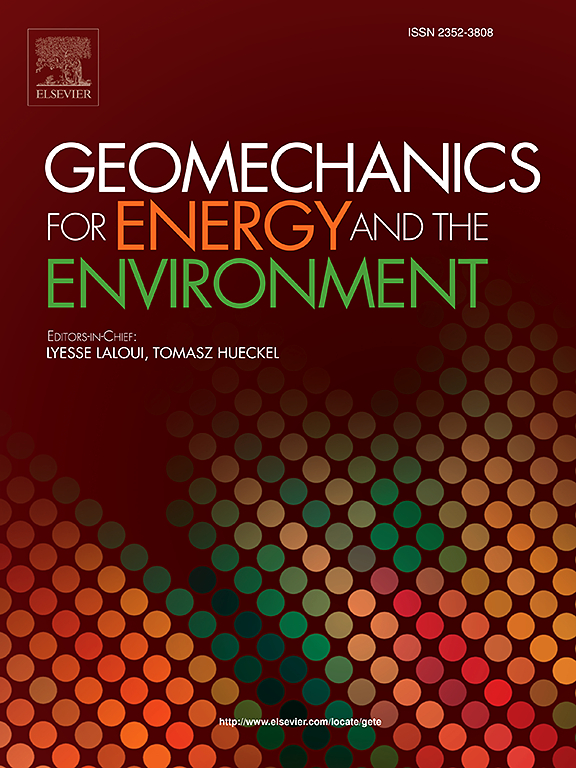利用InSAR和数据同化的综合方法来解开和量化意大利北部拉文纳海岸多深度驱动的下沉原因
IF 3.7
2区 工程技术
Q3 ENERGY & FUELS
引用次数: 0
摘要
直到上世纪末,拉文纳地区(意大利)的地面沉降一直是一种水文地质灾害。虽然在过去的几十年里下沉减少了,但该地区仍然经历着垂直位移。了解它们的驱动因素是一项挑战。地表沉降的大小和分布必须结合地质因素和人类活动来解释。该研究综合了各种数据集、沉降观测和沉降模型,评估了三个主要原因的贡献:与建筑相关的、浅层地下过程和深层地下过程。利用干涉式合成孔径雷达对模型结果进行了优化。在多种原因共同作用的地方,沉降率最高,超过10 毫米/年。与建筑物有关的沉降结果表明,与工业建筑有关的沉降率是住宅建筑的两倍。这种差异在泻湖和填海地区更为明显。浅层原因与潮汐沉积物上的覆盖层重量和填海土地的排水有关,导致沿海地区明显的下沉。海上天然气开采的深层原因造成了部分海岸的下沉,但随着时间的推移,下沉的趋势会逐渐减少。其他因素,如低洼农田排水、(历史上的)地下水开采和第四纪沉积物的压实,由于它们在考虑的时间段内对总沉降的贡献很小,因此没有具体解决。这项研究强调了综合考虑地貌与地质、工业化、城市化和流体开采之间相互作用的重要性。岩土工程评估和改进的沉降模型,结合建筑物和地下流体提取的本地化数据,对于制定有效的缓解战略至关重要。本文章由计算机程序翻译,如有差异,请以英文原文为准。
An integral approach using InSAR and data assimilation to disentangle and quantify multi-depth driven subsidence causes in the Ravenna coastland, Northern Italy
Land subsidence in the Ravenna area (Italy) was a hydrogeological hazard until the end of last century. Although subsidence reduced during the last decades, the area is still experiencing vertical displacements. Understanding their drivers is challenging. Land subsidence magnitude and distribution must be interpreted with a combination of geological factors and human activities. This study integrates various datasets, subsidence observations, and subsidence models to evaluate the contributions of three main causes: building related, shallow subsurface processes and deep subsurface processes. The model result was optimized using Interferometric Synthetic Aperture Radar. The highest subsidence rates, of over 10 mm/year, were found at locations where multiple causes have an effect. The results of building-related subsidence indicate that subsidence rates associated with industrial buildings are twice as high as for residential buildings. This difference is even more pronounced in lagoonal and reclaimed areas. Shallow causes, associated with overburden weight on tidal deposits and drainage of reclaimed land, cause significant subsidence along the coast. Deep causes, by offshore gas extraction, contribute to subsidence along parts of the coast, with a decreasing trend over time. Other factors, such as low-lying farmland drainage, (historical) groundwater extraction and compaction of Quaternary deposits are not specifically addressed because of their small contribution to the total subsidence during the time period considered. This study underscores the importance of a comprehensive approach that considers the interplay between geomorphology and geology, industrialization, urbanization, and fluid extraction. Geotechnical assessments and improved subsidence models, incorporating localized data on buildings and subsurface fluid withdrawals, are crucial for developing effective mitigation strategies.
求助全文
通过发布文献求助,成功后即可免费获取论文全文。
去求助
来源期刊

Geomechanics for Energy and the Environment
Earth and Planetary Sciences-Geotechnical Engineering and Engineering Geology
CiteScore
5.90
自引率
11.80%
发文量
87
期刊介绍:
The aim of the Journal is to publish research results of the highest quality and of lasting importance on the subject of geomechanics, with the focus on applications to geological energy production and storage, and the interaction of soils and rocks with the natural and engineered environment. Special attention is given to concepts and developments of new energy geotechnologies that comprise intrinsic mechanisms protecting the environment against a potential engineering induced damage, hence warranting sustainable usage of energy resources.
The scope of the journal is broad, including fundamental concepts in geomechanics and mechanics of porous media, the experiments and analysis of novel phenomena and applications. Of special interest are issues resulting from coupling of particular physics, chemistry and biology of external forcings, as well as of pore fluid/gas and minerals to the solid mechanics of the medium skeleton and pore fluid mechanics. The multi-scale and inter-scale interactions between the phenomena and the behavior representations are also of particular interest. Contributions to general theoretical approach to these issues, but of potential reference to geomechanics in its context of energy and the environment are also most welcome.
 求助内容:
求助内容: 应助结果提醒方式:
应助结果提醒方式:


